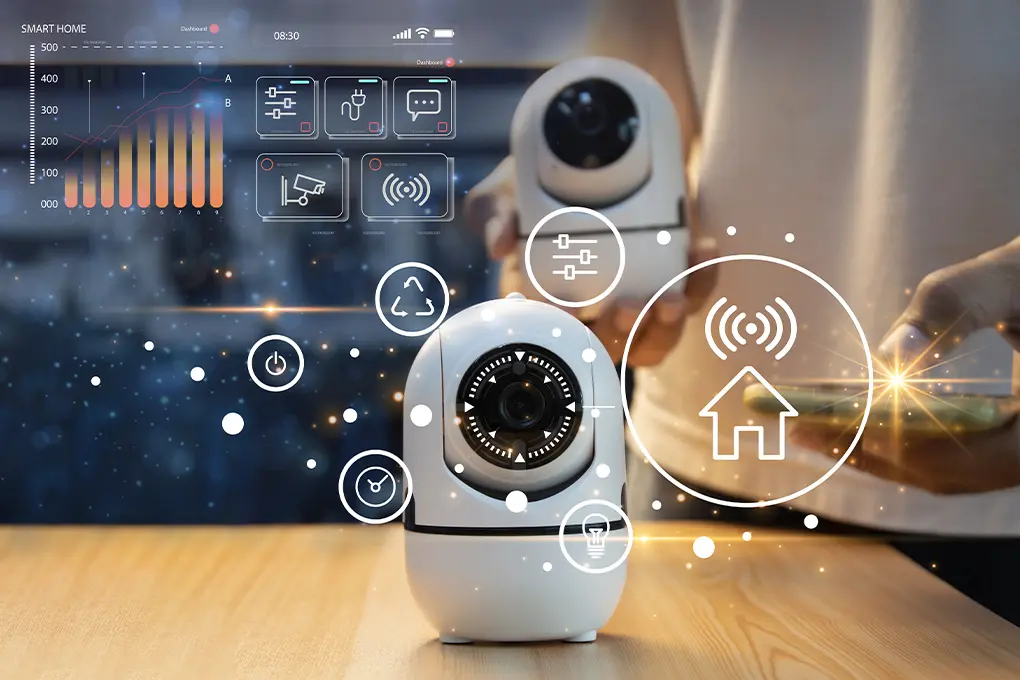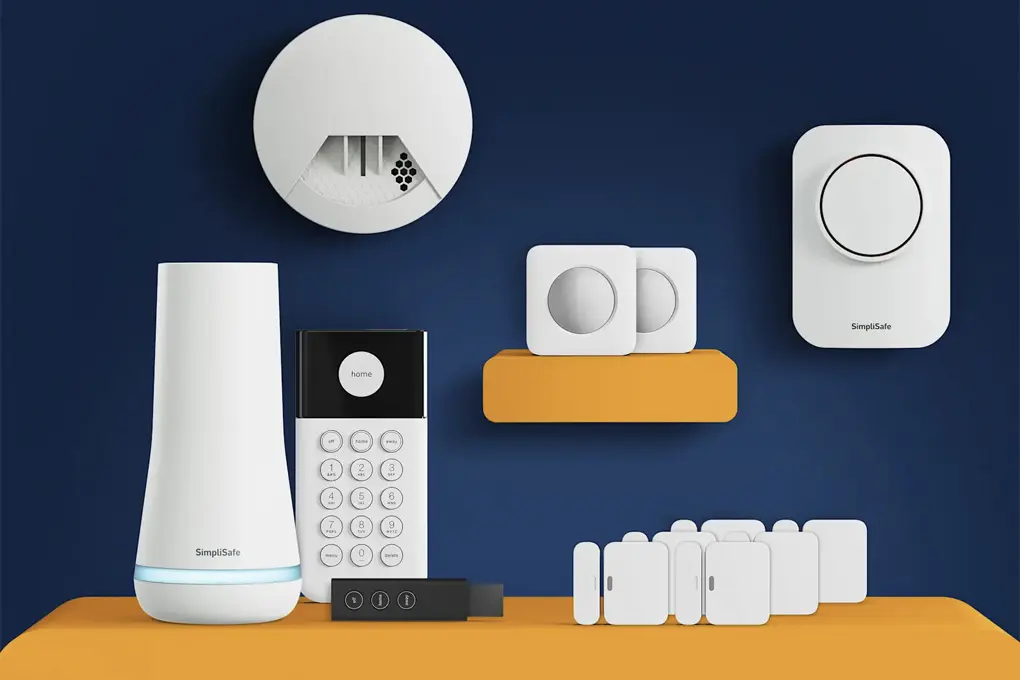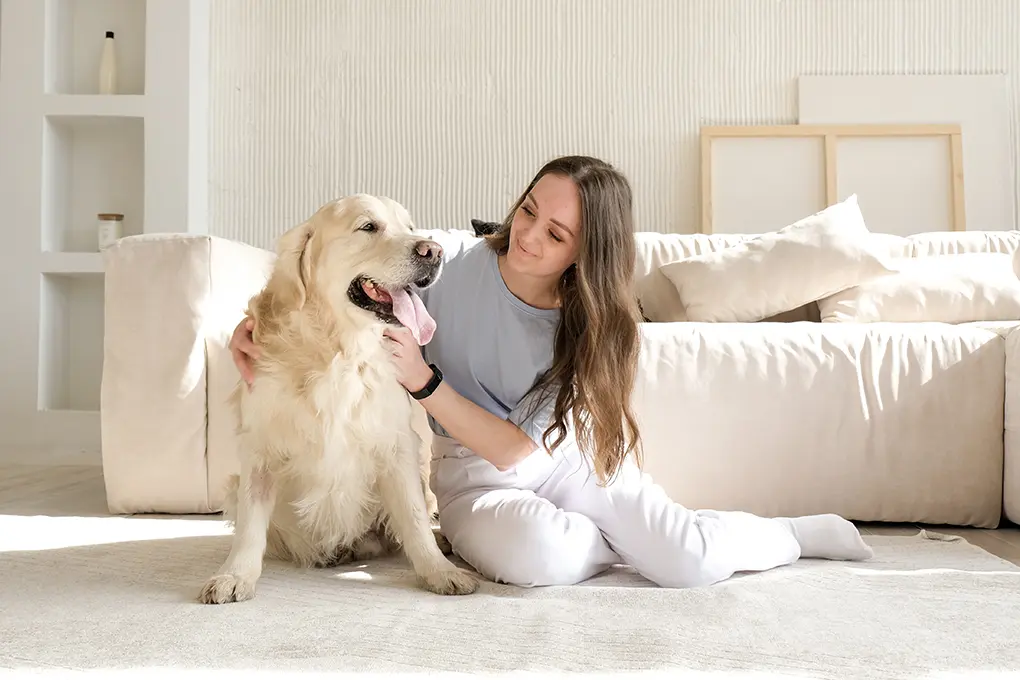If you’re shopping for a smarter way to protect your home, you’ve probably seen the term “AI-powered” slapped on every security product out there. From cameras to doorbells, everything claims to be intelligent, but what does that actually mean for your family’s safety? And is it worth paying for?
Here’s what might surprise you: installing a smart security system can cut your home insurance premiums by up to 20%. That’s not just a perk; it’s proof that insurers are taking AI-based protection seriously.
Still, many homeowners we speak to are cautious. They’ve tried “smart” gadgets before that didn’t live up to the hype.
But when used correctly, AI can solve one of the biggest headaches in home security: constant false alarms. With better detection, faster alerts, and smarter monitoring, it’s a real upgrade. Let’s find out why AI home security is so essential in today’s day and age.
Contents
- Key Takeaways
- The AI Efficiency Gap: What Families Actually Use vs. What’s Marketed
- What AI Actually Does in Modern Home Security Systems
- Current Market Reality and False Alarm Statistics
- The Package Theft Crisis and AI Solutions
- Where Marketing Hype Outpaces Reality
- Practical AI Features Worth Your Investment
- Privacy Implications of AI-Powered Security
- The Real-World Performance Gap
- Future Outlook and Emerging Trends
- Bottom Line: Making Smart Choices About AI Security
- Frequently Asked Questions
Key Takeaways
- AI home security tools are often marketed with complex features most families don’t actually use.
- Smart detection in cameras is most effective for filtering out false alerts and recognizing relevant activity.
- The most useful features include person detection, package alerts, and environmental false alarm filtering.
- Facial recognition works best for families with recurring visitors but performs poorly in low light.
- AI accuracy varies with conditions such as lighting, weather, and camera placement.
- Ongoing subscription fees can quickly exceed the cost of basic hardware and should be factored in.
- For practical, privacy-conscious AI home security options, shop trusted solutions through Batten.
The AI Efficiency Gap: What Families Actually Use vs. What’s Marketed
Our analysis of home security usage highlights a growing gap between the AI-powered features that manufacturers promote and the features families actually use. This “AI Efficiency Gap” reflects a disconnect in the smart home security market.
While companies focus on advanced capabilities like facial recognition, behavior analytics, and predictive alerts, most homeowners prioritize simple, reliable systems that require minimal oversight.
The global smart home security market was valued at USD 33.9 billion in 2024 and is projected to reach USD 82.1 billion by 2030, with a compound annual growth rate of 15.2% from 2025 to 2030. Much of this growth is tied to AI integration.
Yet, the real-world adoption of advanced features remains limited. More than half of households now have at least one smart security device, yet many report relying on only the most basic settings, such as motion-triggered video or mobile alerts.
For families, consistent performance, fast notifications, and low maintenance often matter more than complex analytics. This gap suggests that while AI is becoming more common in product design, everyday users still prioritize function over innovation.
The focus moving forward should be on aligning feature sets with actual household needs, rather than simply adding more technology.
What AI Actually Does in Modern Home Security Systems
Artificial intelligence in home security is primarily used to analyze patterns and improve alert accuracy. Instead of simply detecting motion or sound, AI processes those inputs to determine what type of activity is occurring.
This decision-making may happen locally on the device or through cloud-based servers, depending on the product’s design.
Most AI applications focus on reducing false alerts and improving the clarity of notifications. For example, traditional sensors might trigger when a tree sways or a car passes, but AI-enabled cameras can often tell the difference between that type of motion and a human approaching the property.
By classifying objects and behaviors, AI improves system reliability and reduces unnecessary interruptions.
Current Market Reality and False Alarm Statistics
False alarms remain a major challenge in the home security space. Industry reports show that as many as 95% of alarm activations are false. This high rate has forced several cities, including San Francisco, Detroit, and Las Vegas, to adopt non-response policies unless alarms are verified as real threats.
Verification often depends on AI. Many professional monitoring centers now rely on AI-powered tools that can analyze video feeds and sensor data to confirm activity before dispatching emergency services.
These tools have proven effective, with some providers reporting up to a 90 percent reduction in false alerts. This not only prevents wasted resources but also improves emergency response times when actual incidents occur.
By combining pattern recognition with event classification, AI is helping transform home security systems from reactive sensors into smarter, more reliable solutions.
Smart Detection: Beyond Basic Motion Alerts
AI-powered detection systems go beyond simple motion sensing by analyzing video feeds in real time. These systems evaluate movement patterns, object shapes, and contextual clues to determine what type of activity is taking place.
The goal is to reduce unnecessary notifications and provide more useful, actionable alerts.
For example, the system can identify the difference between a person walking toward your front door and a dog running across the yard. Each type of motion has unique visual characteristics, such as gait, speed, and outline, which AI uses to classify the event.
The following are the most common AI detection categories used in modern home security systems:
- Person Detection: This feature identifies human figures and ignores objects or animals. It is typically used to trigger alerts when someone approaches a door, window, or other monitored area.
- Package Recognition: Systems with package detection can notify you when a delivery is made and alert you if a package is left unattended for a certain period.
- Vehicle Detection: This identifies cars, trucks, or motorcycles entering driveways or nearby streets. Some systems also track how long a vehicle stays in the detection zone.
- Animal Classification: AI distinguishes between common pets like dogs or cats and larger or unknown animals that may require attention. This helps reduce unnecessary alerts while still recognizing potential threats.
Many homeowners find these features most helpful during the initial setup phase. In the first few weeks, users often receive a variety of alerts as they adjust camera angles and sensitivity levels. Smart detection helps filter those alerts, giving families clearer insight into what’s happening around their home.
That said, the accuracy of AI detection depends heavily on environmental conditions. Camera placement, lighting, and weather can all impact performance.
For instance, cameras mounted too high may not accurately distinguish between a person and a large dog. Poor lighting, especially at night, can also cause misclassification. Choosing the right camera settings and positioning is essential for reliable results.
Find the best total security and alarm systems right here.
The Package Theft Crisis and AI Solutions
Package theft has become a nationwide epidemic, with one-quarter of American adults having had a package stolen in 2024, with an average value of $204 per stolen parcel. The scale is staggering: over 1.7 million packages go missing every single day, costing Americans $13.4 billion annually.
This crime surge has made package detection one of the most practical AI applications for home security. 88% of adults are worried about theft of online purchases, and 70% of Americans expect porch pirates to strike more after Black Friday and Cyber Monday sales.
So, how does AI smart detection in cameras, as well as their other main features, help to stop porch pirates in their tracks?
AI Package Protection Features
| Feature | How It Works | Real-World Effectiveness |
| Delivery Detection | Recognizes delivery uniforms and vehicles | Reduces false alerts by 60-80% |
| Package Monitoring | Tracks when packages are placed and removed | Provides evidence for 85% of theft cases |
| Loitering Alerts | Identifies suspicious behavior around delivery areas | Prevents 40-50% of attempted thefts |
| Two-Way Communication | Allows homeowners to speak with delivery drivers | Improves secure placement by 65% |
The technology recognizes delivery uniforms, delivery trucks, and typical package-handling behaviors.
- When a package is delivered, the system can send a specific “package delivered” notification, often with a captured image of the item’s placement.
- If someone approaches the same package later without the context of a delivery, the system sends a different type of alert.
- This distinction helps families manage their deliveries more effectively.
- Parents working from home can know immediately when packages arrive without having to review generic motion alerts throughout the day.
For homes where packages sit unattended for several hours, this targeted monitoring provides peace of mind that valuable deliveries aren’t disappearing unnoticed. Find the best security cameras for porch pirates right here.
Familiar Face Recognition in Practice
Face recognition technology in home security systems allows the AI to learn and identify family members, frequent visitors, and regular service providers. Once the system recognizes someone as familiar, it can adjust its alert behavior accordingly.
Many families find this feature most valuable for managing notifications when teenagers come home from school, when housekeepers or pet sitters have scheduled access, or when elderly family members visit regularly.
Rather than receiving security alerts every time a known person approaches the house, the system can send friendly notifications like “Sarah arrived home” or simply skip the alert entirely.
The accuracy of face recognition varies with lighting conditions, camera angles, and how much the person’s appearance has changed since the system last learned their features.
Most systems require good lighting and clear facial views to work reliably, which means they perform better during daytime hours and struggle with people wearing masks, hats, or sunglasses.
Where Marketing Hype Outpaces Reality
AI has delivered meaningful improvements in home security, but not all advertised capabilities reflect actual performance in everyday conditions. Many manufacturers promote ideal scenarios, while real-world installations often present challenges that limit accuracy and consistency.
The Problem With “Perfect” Accuracy Claims
Manufacturers frequently promote AI accuracy rates of 95% or higher. These figures typically come from controlled lab tests, not residential settings with unpredictable lighting, weather, and movement. No consumer AI system performs at peak accuracy under all conditions.
Common environmental variables can significantly impact performance. Here are some of the key real-world factors that affect AI accuracy:
- Lighting conditions can alter accuracy by 20% to 40%, especially during sunrise, sunset, or with motion-triggered lighting
- Weather events such as rain, snow, or heavy wind can lower detection rates by 15% to 25%
- Camera placement affects performance by up to 50%, especially if angles limit visibility or create blind spots
- Seasonal changes may require users to retrain their systems every three to six months due to shifting shadows and vegetation
While most AI systems perform well under typical conditions, occasional misidentifications are still common. Homeowners should expect to fine-tune alert settings over time and treat AI as a helpful tool, not a flawless solution. The best results come when AI detection is combined with other security layers such as monitoring, physical barriers, and manual verification.
For the best that security has to offer, check out our article on the best outdoor security cameras.
The Subscription Trap Behind AI Features
Another concern with AI-powered security is the recurring cost structure that supports many of its advanced features. Most systems rely on cloud processing for person detection, facial recognition, and smart notifications, which means users must pay monthly fees to access those tools. The base hardware cost is often only a fraction of the long-term expense.
Here are some typical monthly costs for AI-driven features:
- Basic motion alerts are generally included
- Person or vehicle detection ranges from $3 to $10 per camera
- Facial recognition typically costs $5 to $15 per system
- Advanced analytics may add $10 to $25 per month for bundled features
- Cloud video storage costs vary between $3 and $20 depending on retention length and camera count
These fees can add up quickly, especially in homes with multiple cameras. Over time, the total cost of ownership may far exceed traditional systems that offer basic alerts without cloud-based AI functions.
Consumers should evaluate whether they will consistently use premium AI features and factor in the lifetime subscription cost before choosing a system. In many cases, simpler setups with smart positioning and reliable hardware provide sufficient protection without the added expense.
Practical AI Features Worth Your Investment
When choosing an AI-powered home security system, it’s important to focus on features that solve real problems in your home rather than opting for the most advanced or complex options. Practicality and reliability matter more than novelty, especially when balancing performance with cost.
The features below offer the most value to families looking for dependable day-to-day protection.
High-Value AI Applications
These features tend to deliver meaningful benefits for typical home security needs:
- Package and delivery detection is especially helpful for homes that receive frequent deliveries. It’s particularly useful during peak seasons when package theft becomes more common.
- Environmental false alarm reduction is ideal for properties with trees, pets, or high foot traffic. This helps prevent nuisance alerts caused by wind, animals, or street movement.
- Person vs. vehicle detection helps homeowners monitor activity near driveways, sidewalks, or front yards without being overwhelmed by irrelevant alerts.
- Basic facial recognition can be useful for households with teenagers, caregivers, or recurring service providers. It helps confirm who is coming and going without requiring advanced setups.
Features That Often Disappoint
Some AI-powered features promise more than they reliably deliver, especially when used in real-world conditions:
- Behavioral analytics that claim to detect suspicious behavior often lack the consistency needed for everyday use
- Zone-based detection systems may require extensive configuration and frequent adjustment
- Multi-camera coordination rarely performs seamlessly in practice, especially with devices from different manufacturers
- Voice recognition for security alerts is often unreliable and rarely improves system performance in a meaningful way
Matching Features to Actual Needs
If package theft has been a recurring concern, systems with reliable delivery detection should be a priority.
Families frustrated by repeated false alarms will benefit from AI that can distinguish between pets, shadows, and actual threats. In homes with frequent visitors, simple facial recognition can improve awareness without introducing unnecessary complexity.
Cost Considerations and Long-Term Value
When evaluating AI features, consider the total cost over time. Many advanced capabilities require paid subscriptions that can quickly outpace the hardware investment. Before committing, calculate whether the added monthly costs align with your actual use case.
In many cases, a well-positioned camera with reliable motion detection and environmental filtering provides most of the protection a home needs without requiring ongoing payments for features you may not use regularly.
Find all of the best video doorbells in Batten’s Marketplace.
Privacy Implications of AI-Powered Security

AI-enabled security systems can provide valuable detection capabilities, but they also raise important privacy questions. Unlike traditional motion-activated cameras that trigger alerts without deeper analysis, AI systems often collect detailed information about daily activity patterns within and around the home.
These systems may log when family members enter or leave, recognize frequent visitors, and track movement throughout specific areas. As a result, understanding how this data is handled becomes critical for families that prioritize privacy.
How AI Processing Affects Privacy
Some security systems perform AI analysis directly on the device, which keeps your footage inside your local network.
This method offers greater control, as no video leaves the property. Other systems rely on cloud-based processing, sending video feeds to external servers for analysis. In these cases, footage is transmitted and stored on infrastructure owned by the manufacturer or third-party providers.
Both methods have trade-offs. Local processing limits exposure but often comes with higher hardware costs and slower feature updates. Cloud-based systems typically offer more frequent updates and features but may involve greater risk of data sharing or unauthorized access.
Privacy Considerations Checklist
To help you evaluate AI-powered systems, consider the following questions before purchasing:
- Where does the system process video data (locally or in the cloud)?
- How long is recorded footage stored by the company?
- Can law enforcement access your video without a warrant or your consent?
- Is your footage used to train future AI algorithms?
- What happens to your stored data if you cancel your subscription?
Recent Industry Privacy Incidents
Privacy concerns are not hypothetical. In 2024, more than 100,000 Ring customers received compensation after the company reached a settlement with the Federal Trade Commission.
The FTC alleged that Ring mishandled user video data and failed to prevent unauthorized access.
This case highlighted the need for transparency in how security companies collect, store, and use personal footage. It also raised questions about how much control users truly have over their own data.
Choosing a Privacy-Conscious System
For families living in privacy-sensitive areas or those simply seeking more control, devices that handle all analysis locally may be a better choice. These systems reduce the risk of data being stored or accessed externally.
Yet, they often come at a higher cost and may require more manual updates or maintenance.
The trade-off between convenience and privacy should be weighed carefully. Understanding where and how your data is processed is just as important as choosing the right security features.
The Real-World Performance Gap
Our research reveals a significant disconnect between AI marketing promises and actual family usage patterns. Most households use less than 30% of their security system’s AI capabilities, preferring simple, reliable notifications over complex analytics.
What Families Actually Want vs. What’s Marketed:
| Family Priority | AI Marketing Focus | Reality Gap |
| Fewer false alerts | Advanced threat analysis | Basic filtering works better |
| Easy setup | Sophisticated customization | Simple presets preferred |
| Reliable notifications | Predictive behavior modeling | Clear, actionable alerts needed |
| Affordable operation | Premium feature differentiation | Subscription costs become prohibitive |
This efficiency gap suggests that the industry may be over-engineering solutions for problems that simpler technology could solve more effectively and affordably.
Future Outlook and Emerging Trends
The smart home security market shows no signs of slowing, with the Asia-Pacific region expected to experience the most rapid growth between 2024 and 2029, outpacing both Europe and the U.S.. However, the focus is shifting from feature complexity to practical reliability.
Emerging Trends for 2025
- Local AI processing to address privacy concerns
- Integration with smart home ecosystems for automated responses
- Improved accuracy in challenging weather conditions
- Simplified setup processes that don’t require technical expertise
- More transparent pricing models with upfront cost disclosure
Future improvements will likely focus on better accuracy in challenging conditions, reduced false alarm rates, and more sophisticated behavior analysis. However, these advancing capabilities will continue requiring careful evaluation of their practical value for your specific security needs.
For extreme weather preparedness that could affect your security system’s power supply, consider reviewing our backup power preparation guide to ensure your AI-powered security system remains operational during outages. Also, if you live in an area prone to severe weather events, our windstorm safeguarding strategies can help protect both your home and security equipment.
Bottom Line: Making Smart Choices About AI Security
AI home security is a tool that, when applied practically, solves real problems. From reducing false alerts to protecting deliveries, AI-powered systems offer meaningful upgrades over traditional devices.
The most effective systems focus on smart detection in cameras, not flashy features that rarely get used. While facial recognition and advanced analytics sound impressive, most families value simplicity, accuracy, and affordability.
The key is knowing what matters to your household. Look for features that solve real problems, weigh the long-term subscription costs, and don’t overlook privacy settings. A thoughtfully chosen system with smart detection in cameras and practical AI features can protect your home better without creating new headaches.
Want peace of mind without the confusion of overhyped technology? Browse Batten’s expert-recommended home security tools, from smart cameras with proven AI features to reliable alarm systems, and start protecting what matters most with technology that actually works.
Frequently Asked Questions
How Can I Improve AI Detection Accuracy in Poor Lighting?
Use infrared-capable cameras and place lighting near entry points. AI detection improves significantly with consistent light and well-angled cameras.
Can AI Cameras Tell the Difference Between Kids and Adults?
Most smart detection in cameras can recognize general size and movement patterns but may misclassify children as animals or unknown figures in certain lighting conditions.
Are AI Home Security Systems More Vulnerable to Hacking?
Any connected system has risk, but local AI processing reduces exposure. Choose systems with encryption and two-factor authentication.
What Happens to My Video Data If I Cancel My Subscription?
Many providers delete stored data, but some retain footage unless you request removal. Always review your provider’s data retention policy.
Is AI Home Security a Good Fit for Rural Properties?
Yes, but accuracy may vary depending on weather and lighting. Smart detection in cameras helps reduce alerts from animals and wind-blown objects.
Sources
- Smart Home Statistics and Trends 2024
- Smart Home Security Market Size | Industry Report, 2030
- 2025 Home Security Market Report | SafeHome.org
- False Alarm Reduction via AI and Analytics | Security Info Watch
- 2024 Package Theft Annual Report and Statistics | Security.org
- 27 Package Theft Statistics & Trends: A Must-Know in 2024
- Package Theft Statistics (2025): Number per Year, Costs & Trends
- Enhancing Smart Home Security: Anomaly Detection and Face Recognition in Smart Home IoT Devices Using Logit-Boosted CNN Models – PMC
- Edge AI Enabled IoT Framework for Secure Smart Home Infrastructure – ScienceDirect
- FTC Sends Refunds to Ring Customers Stemming from 2023 Settlement over Charges the Company Failed to Block Employees and Hackers from Accessing Consumer Videos | Federal Trade Commission
- Americans Use AI in Everyday Products Without Realizing It
- Home Security Industry Statistics 2025 | ConsumerAffairs®




